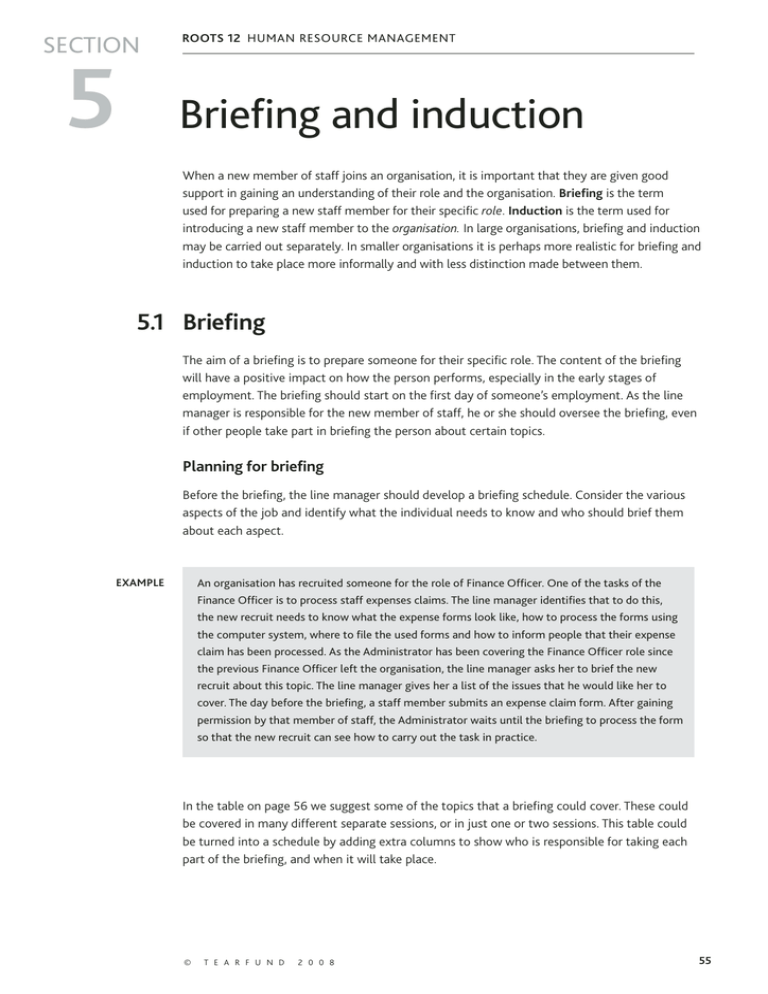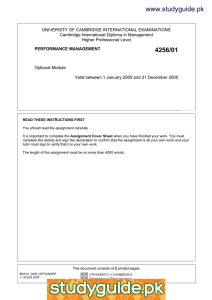5 Briefing and induction SECTION
advertisement

SECTION 5 ROOTS 12 HUMAN RESOURCE MANAGEMENT Briefing and induction When a new member of staff joins an organisation, it is important that they are given good support in gaining an understanding of their role and the organisation. Briefing is the term used for preparing a new staff member for their specific role. Induction is the term used for introducing a new staff member to the organisation. In large organisations, briefing and induction may be carried out separately. In smaller organisations it is perhaps more realistic for briefing and induction to take place more informally and with less distinction made between them. 5.1 Briefing The aim of a briefing is to prepare someone for their specific role. The content of the briefing will have a positive impact on how the person performs, especially in the early stages of employment. The briefing should start on the first day of someone’s employment. As the line manager is responsible for the new member of staff, he or she should oversee the briefing, even if other people take part in briefing the person about certain topics. Planning for briefing Before the briefing, the line manager should develop a briefing schedule. Consider the various aspects of the job and identify what the individual needs to know and who should brief them about each aspect. EXAMPLE An organisation has recruited someone for the role of Finance Officer. One of the tasks of the Finance Officer is to process staff expenses claims. The line manager identifies that to do this, the new recruit needs to know what the expense forms look like, how to process the forms using the computer system, where to file the used forms and how to inform people that their expense claim has been processed. As the Administrator has been covering the Finance Officer role since the previous Finance Officer left the organisation, the line manager asks her to brief the new recruit about this topic. The line manager gives her a list of the issues that he would like her to cover. The day before the briefing, a staff member submits an expense claim form. After gaining permission by that member of staff, the Administrator waits until the briefing to process the form so that the new recruit can see how to carry out the task in practice. In the table on page 56 we suggest some of the topics that a briefing could cover. These could be covered in many different separate sessions, or in just one or two sessions. This table could be turned into a schedule by adding extra columns to show who is responsible for taking each part of the briefing, and when it will take place. © T E A R F U N D 2 0 0 8 55 5 Briefing and induction ROOTS 12 HUMAN RESOURCE MANAGEMENT Type of briefing Suggested content Role briefing with line manager • Organisation’s mission, beliefs, values • Job description – roles and responsibilities (setting objectives) • Personal development needs • Expectations • Handover notes, written procedures Wider job briefing • Organisational chart – the context of the job within the organisation and team • Codes of conduct and any legal matters regarding the role • Team life, such as prayer and meeting times Personnel briefing • Any contract issues still to be discussed • Benefits such as paid leave and medical benefits • Staff handbook • HIV and AIDS workplace policy * • Codes that the organisation recognises, such as People In Aid * (see page 83) * These issues should be covered during the induction, but should also be covered during the briefing if they are particularly relevant to the role. For example, the new recruit should be briefed about child protection if their role involves direct contact with children. • Child protection * (see page 84) Technical briefing • Use of communications and computer equipment Health, safety and security briefing • Buildings and site locations – location of toilets, emergency exits and where to find stationery • Security plan and policy • Health and safety issues Financial briefing • Use of expense sheets for personal and project money • Payroll Prayer • Prayer for the new recruit as they start their new role. For roles that involve implementation of relief and development projects, it can be helpful to give the new recruit information about the background and current situation of the project. Suggested issues to cover are given in the table below. Country Background of the region and community • Map of the area • Historical, political, social and economic background • Current information such as news reports Programme or project Overview of the project or projects in the programme • Project areas • Project proposals • Donors and funding • Time scales Strategy • Organisational strategy • Team strategy Reports 56 T E A R F U N D • Recent reports to donors and the organisation’s board R O O T S R E S O U R C E S 5 Briefing and induction ROOTS 12 HUMAN RESOURCE MANAGEMENT It can also be helpful to set up briefing sessions for the new recruit with other team members, even if they will not work very closely together. This will help the new recruit to understand their context and how their role fits into the team’s work. Handover notes It is best if the person who previously carried out the job can brief the new recruit face-to-face. However, this is not always possible, so written handover notes are essential. The line manager should ensure that the person who previously carried out the job has had time to write these before finishing their contract. Handover notes are helpful, even where there is a face-to-face handover. The notes can guide the discussion and can be referred to later on. Handover notes could include the following: ■ Current context of the role, such as key individuals, external environment, how the role fits into the organisation’s strategy. ■ Any objectives and targets associated with the role. The line manager should set the main objectives with the new staff member. For more information see Section 6 about performance management. ■ Processes and procedures explaining how the role is performed on a day-to-day basis. ■ Standards associated with the role, such as organisational policies and national laws that affect what the person is able to do or how they do it. ■ Any work packages that need to be carried out or completed. The handover notes should be written in consultation with the line manager, as the line manager may wish to alter the role or change processes and procedures. 5.2 Induction The aim of an induction is to introduce a new recruit to the organisation. It should make the new recruit aware of all aspects of the organisation so that they can represent the organisation appropriately. The induction will significantly affect how much an individual feels valued by the organisation. Whether new staff members already know a lot about the organisation or very little, it is important that all new staff members have an induction. People who feel they already know the organisation may only know about certain areas of its work. The induction should be the same for all members of staff. WELCOME PACK It is recommended that people attend an induction within one or two months of the start of their employment. If a number of new staff members join the organisation within a two-month period, it can be helpful for them to go through induction together. This uses time efficiently and can enable © T E A R F U N D 2 0 0 8 57 5 Briefing and induction ROOTS 12 HUMAN RESOURCE MANAGEMENT new recruits to get to know other staff from around the organisation. These personal linkages between departments can be beneficial to the organisation in the long-term because good communication can enhance an organisation’s performance. Content of induction PEOPLE – an opportunity for new members of staff to meet individuals from different parts of the organisation, including leaders such as directors and board members. PROJECTS – an opportunity to visit a community which benefits from the organisation’s work. THE ORGANISATION’S HISTORY – key information about the organisation, including how it was founded, key events in the organisation’s history, how many people it employs, its annual income and how it is governed. THE ORGANISATION’S WORK – the organisation’s vision, values and purpose, and the kinds of projects that it carries out. THE ORGANISATION’S KEY HUMAN RESOURCE THEMES The organisation’s key human resource themes should be communicated during induction because they affect all staff members, whatever their role. These could include: 58 ■ Child protection. All organisations should have a child protection policy in order to protect children from abuse by staff and to help to protect staff from false claims of abuse (see page 84). ■ Benefits. While salaries will differ according to the role, benefits should be the same for all staff members on an employment contract. These benefits might include paid annual leave, and medical schemes. They should be outlined in the staff handbook or contract. ■ Grievance and disciplinary procedures. A grievance procedure ensures that members of staff have a formal way of making a complaint, such as about the way they are treated by another member of staff. A disciplinary procedure enables the organisation to take action when someone’s conduct or performance is viewed as unacceptable. For more details, see Section 6. ■ Standards that the organisation recognises such as those addressing safety, environmental, gender or legal issues. ■ Health and safety. Staff members should be made aware of health and safety procedures. For example, they should know what to do in the case of a fire or other emergency. They should know which staff members can provide first aid. The organisation should seek to protect staff from harm as they carry out their roles, such as giving advice about carrying heavy items, using computer equipment and driving the organisation’s vehicles. ■ Organisational policies, such as an HIV and AIDS workplace policy (see ROOTS 8: HIV and AIDS: Taking action), a gender policy or an environment policy. ■ Staff development. New members of staff should be informed about opportunities for learning. By providing learning opportunities, the organisation can improve staff performance and motivate staff. T E A R F U N D R O O T S R E S O U R C E S 5 Briefing and induction ROOTS 12 HUMAN RESOURCE MANAGEMENT These themes, topics and policies are likely to be outlined in detail in the staff handbook (see Section 3). The induction can therefore provide a good opportunity to distribute a copy of the staff handbook, which can be referred to during relevant sessions. Induction pack It can be helpful to put together an induction pack which contains information to support the induction sessions. Some presenters may refer to the induction pack during their session. Once the induction is over, staff members can refer to the induction pack when necessary. REFLECTION ■ © How are new members of staff introduced to their role when they join our organisation? Is this adequate? If not, what should be included in a briefing? T E A R F U N D 2 0 0 8 ■ How are new members of staff introduced to the organisation? How can this be improved? ■ Do we take care to introduce volunteers to their role and the organisation? 59




